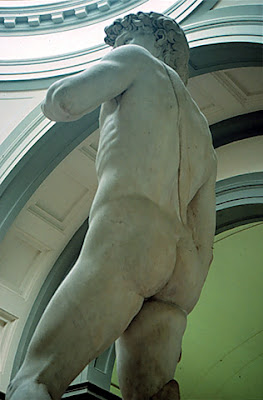Thoughts on Michelangelo's David, commissioned in 1501 and first displayed in 1504.
I have to confess, I was indeed momentarily struck dumb by this piece. Naturally, I expected to be awed, surprised, perhaps even a bit shocked, somehow. What I didn't expect was the almost overwhelming flood of emotion which came over me at the moment of being up close to the statue. There are too few words to express how I felt to see this gargantuan work suddenly looming before me, so grand and so intimate all at once. Well, I can scarcely begin to articulate it. Dare I say the words "Religious Experience"? Would that be too silly a pun?
Let me put it this way: After a few minutes, I moved to the semi-circular gallery behind the statue (where Alle made the observation that all the people seated contentedly behind the great nude work were women, and it was true) and sat on the bench provided there. After regarding the statue for a while, I turned my gaze toward the people approaching for (presumably) the first time. I saw the same thing happen again and again; no matter how old or young, what nationality they seemed, or how jaded they pretended to be (especially the teenagers), every single person approached the foot of the statue, looked up, and was transformed. You could see their expressions sort of melt in the light reflected off the marble, their eyes filling with emotion, just as mine had. They didn't go "blank", exactly, they seemed to be filled, instead.
I found myself watching the people for a long while, loving how they seemed to be touched almost in spite of themselves. Everywhere artists sat on chairs the museum provides, sketching away, some trying to draw the whole work, some trying to do details; a hand, his face, the curve of a hip or thigh. And then my eyes would be drawn back to David himself, at one moment seeing the ill-proportioning of the hands or the oddity of his eyes, the next moment losing those elements and seeing the perfection and fluidity of it all.
Michelangelo broke with tradition in his depiction of David. Most artists chose to show David triumphant, after he had slain Goliath, standing on the head of the giant or holding the decapitated head aloft, sword in hand, or in some other grandiose pose of religious victory and might. As a result, there is some controversy as to when the moment depicted occurred. Does Michelangelo show David immediately before he hurled the stone, before the deed was done and the giant had fallen? Or is it the moment after, when David knows he has succeeded, the tension is fading, his breath is slowing, his heart stilling, yet the adrenaline is still singing in every fiber of his being? The muscles are tight beneath the skin, not lax and smooth in victory, and so they do not dominate the figure at all, as in other statuary. Is he watching from afar, considering that his people are afraid and that he alone has been forced to face the giant? Is he wondering if he will succeed, or die trying? Or is he contemplating what he has done, preparing to exhale away the fear he felt before, and to draw the first, calming breath after it is all over?
I believe it is afterwards, myself. Either interpretation suits the moment, I think.
I learned that if you regard the statue in different light, it seems completely different to the eye. If I gazed at his right hand, curled around the sling at his hip, in moments, it seemed to move. Not to reach out, of course, but to move with his breathing. Naturally, I know it was my own breathing which caused this illusion, but I can understand the myths of marble turning to flesh and blood, now.
And that's all I have to say about that.










No comments:
Post a Comment